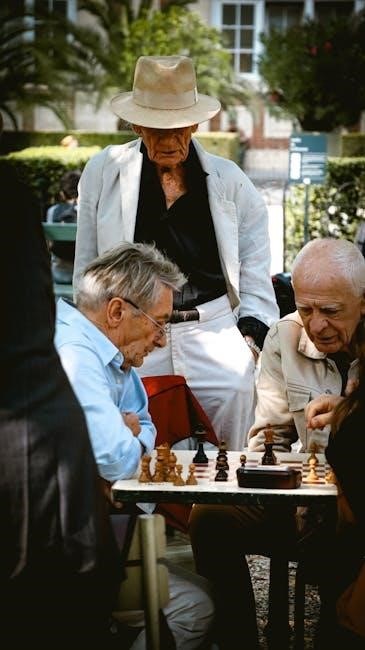Conway’s Game of Life, created by John Conway in 1970, is a zero-player cellular automaton with simple yet profound rules governing cell behavior.
It operates on an infinite grid where cells live, die, or multiply based on neighbor interactions, creating complex patterns from initial configurations.
Overview of the Game
Conway’s Game of Life is a cellular automaton invented by John Conway in 1970, operating on a grid of cells that can be alive or dead. The game evolves deterministically based on simple rules, creating complex patterns from initial configurations. It is a zero-player game, meaning no user interaction is required after setup. The rules govern cell behavior, such as survival, death, and birth, based on neighbor interactions. This simplicity leads to diverse outcomes, including stable patterns (still lifes), oscillating patterns, and expanding structures. The game has become a cornerstone in computational science and education, showcasing emergent complexity from basic rules.
Historical Background and Creation
Conway’s Game of Life was invented in 1970 by British mathematician John Horton Conway, inspired by the concept of cellular automata. Conway developed the game with the goal of creating a simple yet fascinating system that could exhibit complex, life-like behavior. The game was first introduced in a 1970 article in Scientific American, sparking widespread interest and becoming a cornerstone of computational science. Conway meticulously designed the rules after extensive experimentation to ensure the game could produce diverse and intriguing patterns. His work laid the foundation for research in artificial life and complexity theory, making the Game of Life a timeless classic in mathematics and computer science.
Core Rules of the Game of Life
The Game of Life operates on four simple rules that dictate cell survival, death, and birth based on neighbor interactions, enabling complex emergent behaviors from basic principles.
Rule 1: Survival of Live Cells
A live cell with exactly two or three live neighbors survives to the next generation. This rule ensures stability, preventing unnecessary cell death while maintaining balance.
Cells with fewer than two neighbors die due to underpopulation, while those with more than three perish from overpopulation. Rule 1 is crucial for sustaining patterns and enabling complexity in the Game of Life.
Rule 2: Death of Live Cells Due to Underpopulation
A live cell with fewer than two live neighbors dies in the next generation due to underpopulation. This rule ensures that isolated cells cannot survive, promoting interaction and diversity in patterns. Without sufficient neighbors, a cell lacks the “support” needed to sustain life, leading to its extinction. This rule contributes to the dynamic balance of the Game of Life, preventing grids from becoming overly populated with isolated cells. It plays a critical role in maintaining the game’s evolutionary nature.
Rule 3: Death of Live Cells Due to Overpopulation
A live cell with more than three live neighbors dies in the next generation due to overpopulation. This rule prevents excessive density by eliminating cells surrounded by too many others. Overcrowding leads to resource depletion, simulating a natural limitation on growth. This rule balances the game by ensuring that densely packed patterns do not dominate, allowing for a variety of outcomes. It also contributes to the emergence of dynamic and evolving structures, maintaining the game’s complexity and visual interest over time.
Rule 4: Birth of Dead Cells
A dead cell with exactly three live neighbors becomes alive in the next generation, simulating reproduction. This rule introduces new life into the grid, enabling patterns to grow and evolve. It balances the game by counteracting cell death from underpopulation or overpopulation. This reproduction rule is essential for generating diversity and complexity, as it allows for the emergence of oscillators, gliders, and other dynamic structures. It ensures that the game remains engaging and capable of producing infinite variations, making it a cornerstone of Conway’s design.

Key Concepts in the Game of Life
The Game of Life revolves around cellular automata, where cells evolve based on neighbor interactions. Initial configurations shape outcomes, leading to still life, oscillators, or dynamic patterns like gliders and spaceships.
Cellular Automata and Their Significance
Cellular automata are computational systems modeled on biological cells, where each cell follows simple rules to evolve over time. In Conway’s Game of Life, the automaton operates on a grid, with cells transitioning states based on neighbor interactions. This concept, pioneered by John Conway, demonstrates how complex behaviors can emerge from straightforward rules. The significance lies in its ability to simulate life-like processes, making it a cornerstone of theoretical computer science and inspiring research in mathematics, biology, and artificial life.
Initial Configurations and Their Impact
The initial configuration of cells in Conway’s Game of Life plays a crucial role in determining the system’s evolution; Simple starting patterns can lead to stable structures, oscillators, or even expanding patterns. For example, a “glider” configuration can traverse the grid indefinitely, while others form stationary “still lifes.” The sensitivity to initial conditions highlights the game’s complexity and unpredictability. Certain configurations, like Gosper’s Glider Gun, demonstrate the system’s capacity for universal computation. This dependency on initial states underscores the game’s relevance in studying emergent behavior and complexity in computational systems.
Still Life and Oscillator Patterns

Still Life patterns in Conway’s Game of Life are stable configurations that remain unchanged across generations. Examples include the “Block” and “Beehive,” which exhibit no movement or alteration. Oscillator patterns, by contrast, cycle through states periodically. The “Blinker,” a vertical line of three cells, oscillates horizontally every generation. These patterns demonstrate the game’s capacity for both stability and periodic behavior, showcasing how simple rules can generate diverse and fascinating outcomes. They are fundamental to understanding the game’s dynamics and have inspired extensive study in cellular automata theory.
How to Play the Game of Life
To play, start by setting up a grid of cells, each either alive or dead. Count each cell’s live neighbors and apply the rules simultaneously to update the grid.
- Set up the grid with an initial configuration of live and dead cells;
- Count the number of live neighbors for each cell.
- Apply the rules to determine the next state of each cell.
- Update all cells simultaneously to progress the game.
Setting Up the Grid
The Game of Life begins with a grid of square cells, each initially alive or dead. The grid can be finite or infinite, depending on the setup.
Players can manually configure the grid or use random patterns. Specific initial configurations, like still lifes or oscillators, are often chosen for their predictable behavior.
The grid’s boundaries can be set to wrap around (toroidal) or remain fixed. The initial state determines the evolution, making grid setup a critical starting point.
Counting Neighbors and Applying Rules
Each cell in the grid has eight neighbors, located adjacent to it horizontally, vertically, and diagonally. The next state of each cell is determined by counting its live neighbors and applying the Game of Life rules.
A live cell survives if it has two or three live neighbors; otherwise, it dies. A dead cell becomes alive if it has exactly three live neighbors. These rules are applied simultaneously to all cells, ensuring synchronized updates. This neighbor-counting mechanism is central to the Game of Life’s behavior and pattern generation, making it a foundational aspect of cellular automata dynamics.
Updating the Grid Simultaneously
The Game of Life updates all cells at the same time, meaning no cell’s new state is based on another’s updated state within the same generation. This ensures consistency and prevents intermediate states from influencing the outcome prematurely.
Simultaneous updates are critical for maintaining the integrity of the cellular automaton. Each cell’s next state is determined solely by its current configuration and neighbor count, guaranteeing deterministic behavior. This synchronized approach allows the grid to evolve uniformly, enabling the emergence of complex patterns and behaviors that define the Game of Life’s unique dynamics.

Mathematical Foundations
Conway’s Game of Life is rooted in cellular automata, a mathematical system where cells evolve based on deterministic rules, creating complex patterns from simple initial conditions.
John Conway’s Contribution to Mathematics
John Conway, a renowned British mathematician, revolutionized cellular automata with his Game of Life, demonstrating how simple rules could produce complex, emergent behaviors.
His work spanned number theory, combinatorial game theory, and algebra, notably the ATLAS project and the discovery of Conway groups.
The Game of Life exemplifies his fascination with how simple systems can generate intricate patterns, influencing fields like computer science and theoretical biology.
Conway’s contributions remain foundational, inspiring research in complexity and self-organization, leaving a lasting legacy in mathematics and beyond.
Algorithms and Computations in the Game of Life
The Game of Life relies on straightforward yet powerful algorithms to simulate cellular behavior. At its core, the computation involves counting live neighbors for each cell and applying the rules simultaneously across the grid.
Efficient implementations often use matrix operations or bitwise manipulations to handle large grids. The game’s universal Turing completeness highlights its potential for simulating complex computations, enabling it to model diverse systems.
Algorithms must ensure synchronous updates to maintain consistency, as asynchronous changes would disrupt the game’s deterministic nature. This structured approach allows researchers to explore emergent patterns and behavioral complexity arising from simple rules.

Universality and Turing Completeness
Conway’s Game of Life is Turing complete, meaning it can simulate any Turing machine and perform universal computation. This property arises from its ability to represent and manipulate data through cell patterns.
Specific configurations, such as gliders and glider guns, act as universal constructors, enabling the implementation of logical gates and circuits. These patterns allow the Game of Life to compute any algorithm, demonstrating its computational universality.
This capability highlights the profound connection between simple rules and complex behavior, making the Game of Life a cornerstone in theoretical computer science and cellular automata research.

Common Patterns and Their Behavior
The Game of Life features diverse patterns like Still Life, Oscillators, and Spaceships. These patterns emerge from the rules, exhibiting stable, periodic, or moving behaviors.
Still Life Patterns
Still Life Patterns in Conway’s Game of Life are configurations that remain unchanged over generations. These patterns are stable because their cell arrangements adhere to the game’s rules, preventing further changes. Common examples include the Block, Beehive, and Loaf. Each maintains its structure as live cells have exactly two or three neighbors, preventing death or birth. These patterns are fundamental in understanding the game’s behavior and serve as building blocks in more complex setups, showcasing how simplicity leads to stability.
In the Game of Life, Still Life Patterns are crucial for their simplicity and stability. They provide insights into how initial configurations can result in unchanging structures. The Block, a 2×2 square of four mutually supportive cells, is the simplest Still Life. The Beehive and Loaf have unique shapes that satisfy the rules, ensuring their longevity. These patterns exemplify the emergent complexity arising from simple rules, making them essential for studying cellular automata and their applications in computational science and education.
Oscillator Patterns
Oscillator Patterns in Conway’s Game of Life are configurations that repeatedly cycle through states without stabilizing. These patterns exhibit periodic behavior, returning to their initial arrangement after a set number of generations. The Blinker, a 3×1 line of cells, is a classic example, oscillating between horizontal and vertical orientations every generation. Other oscillators, like the Pulsar, involve larger structures and longer periods. These patterns are vital for studying how simple rules can generate dynamic, repeating behaviors. They demonstrate the game’s potential for complexity and are often used in education to illustrate emergent properties in cellular automata.

Spaceship Patterns
Spaceship Patterns in Conway’s Game of Life are configurations that move across the grid, exhibiting displacement over time. The most famous example is the Glider, a small, four-cell pattern that shifts diagonally every four generations. These patterns demonstrate how simple rules can produce mobile, self-sustaining structures. Unlike still lifes or oscillators, spaceships exhibit indefinite movement, making them crucial for understanding the game’s potential for complexity. They follow the core rules of cell survival, death, and birth, showcasing the game’s ability to generate dynamic, traveling entities. These patterns are essential for exploring emergent behavior in cellular automata.

Applications and Implications
The Game of Life has profound implications in computational science, education, and artificial life studies, demonstrating how simple rules can generate complex, emergent behaviors, bridging theory and practice.
Role in Computational Science
Conway’s Game of Life significantly impacts computational science by illustrating complex systems’ emergence from simple rules. It serves as a model for studying self-organization and parallel processing, demonstrating how basic interactions can lead to sophisticated patterns and behaviors. Researchers use it to explore chaos theory, universal computation, and cellular automata principles. Its applications extend to simulating biological processes and testing theoretical frameworks, making it a cornerstone in understanding complex systems dynamics.
Use in Education and Research
Conway’s Game of Life is widely used in education to teach concepts like cellular automata, complexity, and self-organization. It simplifies complex systems for students, making abstract ideas accessible. Researchers leverage its simplicity to model biological processes, study pattern emergence, and explore computational theory. Its visual nature aids in illustrating how simple rules can generate intricate behaviors, making it a valuable tool for interdisciplinary studies and hands-on learning experiences in mathematics, computer science, and biology.
Connection to Artificial Life
Conway’s Game of Life has profound connections to artificial life (ALife), as it demonstrates how simple rules can generate complex, life-like behaviors. The game illustrates self-organization, emergence, and the spontaneous creation of patterns that mimic biological systems. It has inspired research into evolutionary dynamics, self-replication, and the origins of life. By simulating life-like processes, the game provides a framework for understanding how simple rules can lead to intricate behaviors, making it a cornerstone in the study of artificial life and its potential to simulate living systems digitally.

Resources and References
The Game of Life rules are detailed in various PDF guides, academic papers, and online documentation, providing comprehensive insights for researchers and enthusiasts alike.
PDF Guides and Documentation
PDF guides and documentation on Conway’s Game of Life provide detailed explanations of the rules, patterns, and mathematical foundations. These resources often include visual examples, such as the “lifeSlides.pdf,” which outlines the evolution of cells and initial configurations. Academic papers and documentation, like those referenced from MIT and other institutions, offer in-depth analysis for researchers. They also highlight contributions from John Conway and the broader implications of cellular automata. These PDFs are invaluable for both educators and enthusiasts, serving as comprehensive references for understanding and implementing the Game of Life.
Online Simulators and Tools
Online simulators and tools for Conway’s Game of Life allow users to experiment with the game’s rules and patterns interactively. These tools, such as web-based platforms, enable users to create and simulate custom configurations, observe emergent behaviors, and explore complex patterns like still lifes and oscillators. Many simulators offer features like step-by-step evolution, neighbor counting, and pre-built pattern libraries. They are invaluable for educational purposes, research, and casual exploration, providing visual and dynamic insights into how the Game of Life operates under its foundational rules.
Academic Papers and Further Reading
Academic papers on Conway’s Game of Life delve into its mathematical foundations, cellular automata theory, and emergent behaviors. Notable works by John Conway and other researchers explore the game’s universality, Turing completeness, and applications in computational science. Papers from MIT, Princeton, and other institutions provide in-depth analyses of patterns, rules, and theoretical implications. These resources are available through academic databases, university repositories, and dedicated research portals, offering insights for both beginners and advanced scholars interested in the game’s profound mathematical and computational significance.
Conway’s Game of Life remains a timeless marvel in mathematics and computational science, inspiring future research and community-driven innovations, ensuring its enduring relevance and fascination.

Evolution of the Game of Life
The Game of Life, invented by John Conway in 1970, has evolved significantly since its inception. Initially a theoretical concept, it gained popularity through computer implementations and visualizations. Over time, enthusiasts discovered complex patterns, such as gliders and oscillators, revealing the depth of its simple rules. Variations like HighLife and Day and Night have emerged, introducing new dynamics while maintaining the core principles. These advancements demonstrate how foundational rules can lead to endless creativity and innovation, ensuring the game’s enduring relevance in computational science and beyond.
Modern computational tools and online simulators have further expanded its reach, enabling users to experiment with custom rules and patterns. This accessibility has fostered a thriving community, driving continuous exploration and innovation. The evolution of the Game of Life highlights its versatility as both a mathematical curiosity and a creative outlet, inspiring future generations to explore its infinite possibilities.
Community Contributions and Variations
The Game of Life has inspired a vibrant community that continues to explore its possibilities. Enthusiasts have created numerous variations, such as HighLife and Day and Night, which modify the original rules to produce unique behaviors. These variations maintain the core concept of cellular automata while introducing new dynamics. Community members have also developed sophisticated patterns, like gliders and oscillators, which showcase the game’s depth. Online forums and open-source tools have further facilitated collaboration, allowing users to share custom rules and configurations. This collective creativity ensures the game remains a dynamic and evolving system, fostering endless innovation and discovery.
Potential for Future Discoveries
Conway’s Game of Life remains a fertile ground for exploration, with its simple rules hiding immense complexity. Future discoveries may uncover new patterns, such as novel spaceships or oscillators, and deeper insights into its theoretical foundations. Advances in computational power and AI could accelerate pattern discovery and analysis. Researchers may also explore higher-dimensional versions or alternative rule sets, expanding the game’s possibilities. The game’s connection to theoretical computer science, particularly its Turing completeness, suggests unexplored avenues in algorithm design and universality. As new tools and methodologies emerge, the Game of Life will continue to inspire breakthroughs in mathematics and complexity science.
